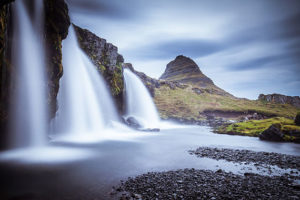Photography Tips – Capturing Sunny Waterfalls
Flowing water forms part of many interesting photographic scenes. But what is the best way for photographers to capture it? The article 3 Top Tips For Photographing Flowing Water covered some of the best techniques for capturing stunning images of waterfalls and flowing water, this article explains how to get the best waterfall images on a bright sunny day – when low light is at a premium.
Although the best lighting conditions for this type of photography are dull low-light days, or using the low light of dawn and dusk, all is not lost if the sun is shining brightly, or is high in the sky. However, additional equipment is usually required.
Top Tip #1 – Use An ND Filter
The best additional piece of equipment for photography of flowing water in bright light is the humble filter. A neutral density (ND) filter is the best filter for lengthening the exposure time. These have no effect on the tone of the image, just the amount of light entering the camera, and come in a variety of densities (and hence strengths of effect). Typical densities are 1stop, 2stops or 3stops of extra exposure being required/allowed for correct exposure of the image. This doesn’t reduce the light sufficiently? Solution: add another ND filter on top, and keep stacking them until the light is reduced to acceptable levels!
If a filter holder is used, then there is a limit on the number of filters than can be stacked at one time. However, there is nothing to stop the photographer from dispensing with the filter holder, and holding the filters by the edges just in front of the lens. Lens hoods will need to be removed for this technique, so care should be taken to ensure that some other form of shade prevents direct light crossing the lens. This could be as simple as a hand cupped round the sunny side of the lens (this is possible with one hand while holding a stack of filters, but isn’t easy, and may require practice!)
Top Tip #2 Use a Polarising Filter
Polarising filters are also useful for reducing shutter speed as the polarising effect reduces the amount of light able to pass through the filter. They have additional benefits on bright sunny days, as they can also help reduce “hot” reflective spots caused by bright sunlight on foliage, wet rocks, or even water droplets themselves, which would otherwise appear as burnt-out white spots on the photograph.
Top Tip #3: Use The Natural Shadows
Choosing parts of the stream or waterfall that are overshadowed by trees or other structures will help cut down the light to a more manageable level and reduce the need for filters, or smaller apertures than are ideal for the creative effect required.
One of the classic techniques for photographing fast flowing water is to use the silky silver blur effect. This article explains how to get this effect even on a bright sunny day. The author of this article is an award-winning landscape, travel and adventure sports photographer based on the fringes of the Peak District in the UK.





